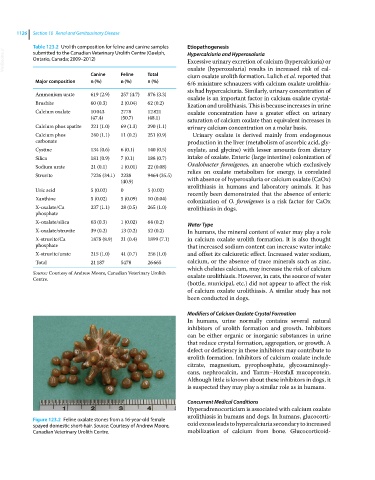Page 1188 - Clinical Small Animal Internal Medicine
P. 1188
1126 Section 10 Renal and Genitourinary Disease
Table 123.2 Urolith composition for feline and canine samples Etiopathogenesis
VetBooks.ir Ontario, Canada; 2009–2012) Hypercalciuria and Hyperoxaluria
submitted to the Canadian Veterinary Urolith Centre (Guelph,
Excessive urinary excretion of calcium (hypercalciuria) or
Canine Feline Total oxalate (hyperoxaluria) results in increased risk of cal
cium oxalate urolith formation. Lulich et al. reported that
Major composition n (%) n (%) n (%) 6/6 miniature schnauzers with calcium oxalate urolithia
sis had hypercalciuria. Similarly, urinary concentration of
Ammonium urate 619 (2.9) 257 (4.7) 876 (3.3)
oxalate is an important factor in calcium oxalate crystal
Brushite 60 (0.3) 2 (0.04) 62 (0.2) lization and urolithiasis. This is because increases in urine
Calcium oxalate 10 043 2778 12 821 oxalate concentration have a greater effect on urinary
(47.4) (50.7) (48.1) saturation of calcium oxalate than equivalent increases in
Calcium phos apatite 221 (1.0) 69 (1.3) 290 (1.1) urinary calcium concentration on a molar basis.
Calcium phos 240 (1.1) 11 (0.2) 251 (0.9) Urinary oxalate is derived mainly from endogenous
carbonate production in the liver (metabolism of ascorbic acid, gly
Cystine 134 (0.6) 6 (0.1) 140 (0.5) oxylate, and glycine) with lesser amounts from dietary
Silica 181 (0.9) 7 (0.1) 188 (0.7) intake of oxalate. Enteric (large intestine) colonization of
Oxalobacter formigenes, an anaerobe which exclusively
Sodium urate 21 (0.1) 1 (0.01) 22 (0.08)
relies on oxalate metabolism for energy, is correlated
Struvite 7226 (34.1) 2238 9464 (35.5) with absence of hyperoxaluria or calcium oxalate (CaOx)
(40.9)
urolithiasis in humans and laboratory animals. It has
Uric acid 5 (0.02) 0 5 (0.02)
recently been demonstrated that the absence of enteric
Xanthine 5 (0.02) 5 (0.09) 10 (0.04) colonization of O. formigenes is a risk factor for CaOx
X‐oxalate/Ca 237 (1.1) 28 (0.5) 265 (1.0) urolithiasis in dogs.
phosphate
X‐oxalate/silica 63 (0.3) 1 (0.02) 64 (0.2) Water Type
X‐oxalate/struvite 39 (0.2) 13 (0.2) 52 (0.2) In humans, the mineral content of water may play a role
X‐struvite/Ca 1878 (8.9) 21 (0.4) 1899 (7.1) in calcium oxalate urolith formation. It is also thought
phosphate that increased sodium content can increase water intake
X‐struvite/urate 215 (1.0) 41 (0.7) 256 (1.0) and offset its calciuretic effect. Increased water sodium,
Total 21 187 5478 26 665 calcium, or the absence of trace minerals such as zinc,
which chelates calcium, may increase the risk of calcium
Source: Courtesy of Andrew Moore, Canadian Veterinary Urolith oxalate urolithiasis. However, in cats, the source of water
Centre.
(bottle, municipal, etc.) did not appear to affect the risk
of calcium oxalate urolithiasis. A similar study has not
been conducted in dogs.
Modifiers of Calcium Oxalate Crystal Formation
In humans, urine normally contains several natural
inhibitors of urolith formation and growth. Inhibitors
can be either organic or inorganic substances in urine
that reduce crystal formation, aggregation, or growth. A
defect or deficiency in these inhibitors may contribute to
urolith formation. Inhibitors of calcium oxalate include
citrate, magnesium, pyrophosphate, glycosaminogly
cans, nephrocalcin, and Tamm–Horsfall mucoprotein.
Although little is known about these inhibitors in dogs, it
is suspected they may play a similar role as in humans.
Concurrent Medical Conditions
Hyperadrenocorticism is associated with calcium oxalate
urolithiasis in humans and dogs. In humans, glucocorti
Figure 123.2 Feline oxalate stones from a 16‐year‐old female
spayed domestic short‐hair. Source: Courtesy of Andrew Moore, coid excess leads to hypercalciuria secondary to increased
Canadian Veterinary Urolith Centre. mobilization of calcium from bone. Glucocorticoid‐

